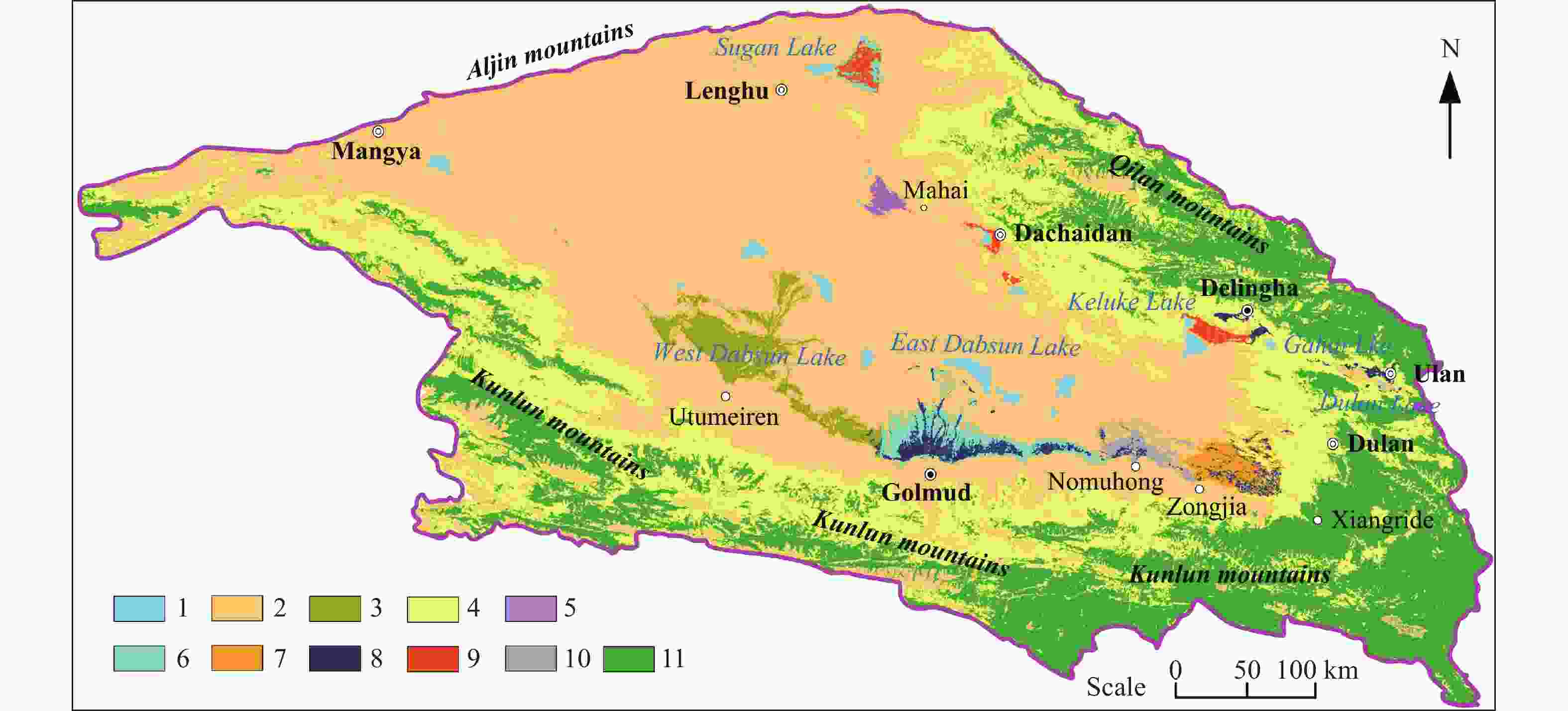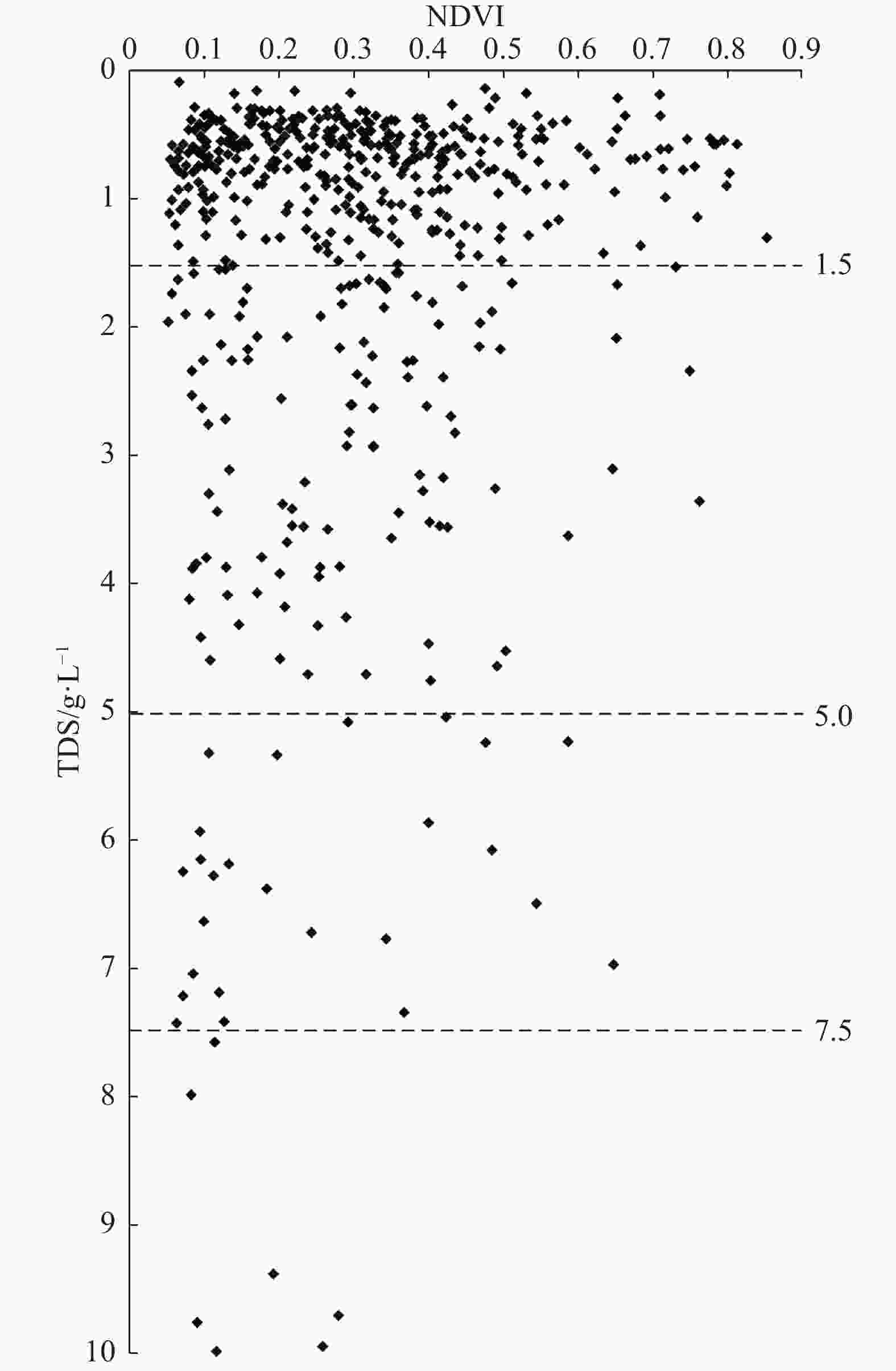-
Abstract: To accurately evaluate ecological risks trigged by groundwater exploitation, it must be clarified the relationship between vegetation and groundwater. Based on remote sensing data sets MOD13Q1, groundwater table depth (WTD) and total dissolved solids (TDS), the relationship between groundwater and natural vegetation was analyzed statistically in the main plain areas of Qaidam Basin. The results indicate that natural vegetation is groundwater-dependent in areas where WTD is less than 5.5 m and TDS is less than 7.5 g/L. Aquatic vegetation, hygrophytic vegetation and hygrophytic saline-alkali tolerant vegetation are mainly distributed in areas with WTD <1.1 m. Salt-tolerant and mesophytic vegetation mainly occur in areas with WTD of 1.4-3.5 m, while the xerophytic vegetation isprimarily present in areas where WTD ranges from 1.4 m to 5.5 m. Natural vegetation does not necessarily depend on groundwater in areas with WTD >5.5 m. For natural vegetation, the most suitable water TDS is less than 1.5 g/L, the moderately suitable TDS is 1.5-5.0 g/L, the basically suitable TDS is 5.0-7.5 g/L, and the unsuitable TDS is more than 7.5 g/L.
-
Key words:
- Qaidam Basin /
- Natural vegetation /
- Water table depth /
- Total dissolved solids /
- Dependencies
-
Figure 1. Distribution of main vegetation in Qaidam Basin
Note: 1-Lake; 2-Bare land; 3-It is mainly Phragmites australis, followed by Tamarix ramosissima Lcdcb, Nitraria tangutorum Bor; 4-It is mainly Artemisia desterorum Spreng, followed by Nitraria tangutorum Bobr, Calligonum mongolicum, Tamarix ramosissima Lcdcb and so on; 5-Tamarix ramosissima Lcdcb, Artemisia sphaerocephala; 6-Artemisia sphaerocephala; 7-Artemisia sphaerocephala, Tamarix ramosissima Lcdcb, Nitraria tangutorum Bor; 8-Woodland, farmland; 9-Grass land; 10-It is mainly Phragmites australis, followed by Tamarix ramosissima Lcdcb, Artemisia sphaerocephala, Calligonum mongolicum; 11-Alpine vegetation.
Table 1. Themain plant types andtheir growth habits in Qaidam Basin
Type Plant name Habits and regional distribution characteristics Herbaceous plants Salsola abrotanoides Drought resistant and salt tolerant. The suitable environments are desolate Gobi desert, saline sandy soil. The maximum root depth is 0.2 m.
Agropyron cristatum Prefer dry and cold. The suitable environments are dry grass land, hillsides, hills and sand. The maximum root depth <1.0 m.
Leymus Drought resistance, cold resistance, mild salt resistance. The suitable environments are good moisture condition, valley-alluvial plain with less salinization, canal edge, growing low in dry or heavily salted environments. The maximum root depth <1.1m. Dwarf phragmites australis Resistance to drought, wind and sand. It is suitable for growing in the meadow salinized sand land and saline-alkali beach with WTD to be 1.0-5.0 m. The maximum root depth <1.5 m. Achnatherum splendens It likes to grow in the mild salinized soil, slightly alkaline grass beach with WTD to be about 1.5 m. The maximum root depth is 0.8-1.5 m.
Subshrubs Sympegma regelii Prefer dry and cold. They are fond of stony mounds, gravel slopes and mound tops, and can also be found in soil with alkaline soil. The maximum root depth is 0.20-0.25 m. Apocynum venetum Alkali-resisting. Salt alkali land with WTD to be 1.0-3.0 m, sandy wasteland and tidal land. The maximum root depth is 0.3-4.0 m.
Ceratoides Drought resistance, cold resistance, barren tolerance. They are fond of Gobi, desert, semi-desert, arid hillside or grassland. The maximum root depth is about 0.6 m. Artemisia desterorum Spreng Cold resistance, drought resistance, sand resistance.They are fond of semi-mobile dune, semi-fixed dune, fixed dune, flat sandy land, sand-covered Gobi, dry riverbed. The maximum root depth is 1.5-4.0 m. Shrubs Kalidium foliatum Alkali-resisting. They mostly developed in the front edge of the alluvial fan, the lake and the loamy salt land of the alluvial plain with WTD to be 1.0-1.5 m. The maximum root depth is 0.15-0.20 m. Qaidam Lycium ruthenicum Drought resistance, salt and alkali resistance, cold resistance, high temperature resistance. They are fond of lake basins, alluvial fans, river banks, aeolian dune margins and intermontane saline plains. The maximum root depth <0.5 m. Nitraria tangutorum Bobr Like alkali, drought resistance, wind erosion resistance, sand buried resistance. They grow in more serious salinization, the sandy land with WTD to be 1.0-2.0 m or clay with aeolian sand. The maximum root depth is 1.0-3.0 m. Ephedra przewalskii Heat resistant, cold resistant, like drought. They are fond of hillsides, plains, dry wasteland, river beds and grasslands. The maximum root depth >2.0 m. Calligonum mongolicum Strong xerophyte, drought and high temperature resistance. They are fond of dune, sandy gravel desert. The maximum root depth <6.0 m. Tamarix ramosissima Lcdcb Drought resistant, heat resistant, like the sun. They are fond of floodplain, valley terraces, sandy and clayey salinized plains, dunes. The maximum root depth <10.0 m. Tamarix chinensis Lour Resistance to sand and wind erosion, salt and alkali and drought resistance.They are fond of desert with WTD to be 3.0-5.0 m, loamy saline soil with WTD to be 1.0-2.0 m. The maximum root depth <10.0 m. Small trees Haloxylon ammodendron Drought resistance, heat resistance, cold resistance, salt and alkali resistance.They are fond of dune with WTD of 3.0-4.0 m,moderate and mildly saline soil, the diluvial Gobi with special water shortage. The taproot length is 2.0 m, and the deepest can reach 4.0-5.0 m. Table 2. Size of ecological landscape in the study area
Study area Distance from
the mountain of
groundwater
seepage zone /kmArea/km2 The proportion of oasis area in vegetation distribution area /% Total Gobi oasis salt
marshAgricultural
plantingUrban Utumeiren 40 5 500 530 1 660 3 310 0 0 0 Golmod 30 5 400 760 2 140 2 500 74 51 74 Delingha 16-28 940 146 685 0 215 40 73 Nomuhong-Zongjia 15-30 3 180 1 580 1 600 0 75 0 50 Ulan
BasinNorth Area of Dulan
Lake-Koko salt Lake5-6 285 30 220 0 66 14 77 South Area of Dulan
Lake-Koko salt Lake3-5 210 110 74 0 0 0 35 Table 3. Sampling time and control situation
Study area Data acquisition time Water table points TDS sample points Controlled area/km2 Number/ Point Density/ point/10 km2 number/ point Density/ point /10 km2 Golmud Plain June to September, 2015 1 300 346 2.66 233 1.79 Delingha Plain June to September, 2016 780 176 2.26 192 2.46 Ulan Basin June to September, 2012 398 120 3.02 45 1.13 Nomuhong-Zongjia Plain July to September, 2010 and July to September, 2011 1 430 141 0.99 143 1.00 Utumeiren Plain July to September, 2010 and July to September, 2011 530 131 2.47 115 2.17 -
Chen ZR, Zhang WY. 1987, The characters of ecosystem in the Qaidam Basin and its control mechanism. Journal Arid Land Resources and Environment, 1(2): 115-122. Cheng XR, Huang YB, Shao MA. 2008. Relationship between fine roots distribution and soil water consumption of Populussimonii and Caraganakorshinkii plantation on sandy land. Science of Soil and Water Conservation, 6(5): 77-83. Dang XY, Lu N, G XF, et al. 2019. Groundwater threshold of ecological vegetation in QaidamBasin. Hydrogeology and Engineering Geology, 46(3): 1-8. Dang XY, Zhang G, Chang L, et al. 2015. The hydrogeological survey report to key areas in Qaidam Basin(1/50 000). Xi’an: Technology Report of Xi'an Center of Geological Survey: CGS. Xi’an. Jin XM. 2010. Quantitative relationship between the desert vegetation and groundwater depth in Ejina Oasis, the Heihe River Basin. Earth Science Frontiers, 17(6): 181-186. Jin XM, Liu JT, Xia W. 2014a. Variation of vegetation coverage and its relationship with groundwater in Wutumeiren Area of the Qaidam Basin. Earth Science Frontiers, 21(4): 100-106. Jin XM, Wan L, Zhang YK, et al. 2007. A study of the relationship between vegetation growth and groundwater in the Yin-chuan Plain. Earth Science Frontiers, 14(3): 197-203. doi: 10.1016/S1872-5791(07)60026-8 Jin XM, Xia W, Guo RH. 2014b. Variation of vegetation coverage in the Dulan Area of Qaidam River Basin. Journal of Desert Research, 34(2): 603-609. Li XC, Hu SJ, Li YT, et al. 2008. Study on the root distribution and soil mostuire dynamics under Phragmites arid regions. Acta Prataculturae Sinica, 4: 97-101. Liu YH. 2000. Water resource reasonable exploitation and environmental protection in QaidamBasin. Beijing: Science Press. Lu N, Jin X M. 2015. Laws of vegetation distribution and evolutionary trend and analysis of the influencing factors in Qaidam Basin. Yellow River, 37(1): 94-98. Shi YJ. 2003. The ecological environment of desertification in western China and its governance. Journal of Traditional Chinese Veterinary Medicine, Sup1: 139-166. Sun SZ. 1989. The vegetation of Qaidam Basin and its surrounding mountains. Acta Phytoecologica Et Geobotanica Sinica, 13(3): 236-249. Tie SN, Ma XF, Wang NF. 2015. Analysis of plant characteristics and distribution status in desertification area of the Qinghai-Tibet Plateau. Value Engineering, 26: 163-167. Wang YG, Guo HY, Li J. 2008. Investigation and evaluation of groundwater resources and its environmental problems in Qaidam Basin. Geological Survey Series of Achievements, CGS. Beijing: Geology Press. Wang WQ, Jia YB, Xu LM, et al. 1997. Study on the root distribution of Populustomenosa. Journal of Agricultural University of Hebei, 20(1): 25-29. Xu HF, Guo WX, Yang GZ. 1994. Preliminary determination of the root system of Leymus. Qinghai Prataculture, 3(1): 25-27. Yang GZ, Zhang HJ, Shang YC. 1994. The protection, cultivation and reasonable utilization of reed grassland. China Grassland, 6: 58-61. Yang ZY, Wang WK, Huang JT, et al. 2006. Research on buried depth of eco-safety about groundwater tablein the blown-sand region of the Northern Shaanxi Province. The Journal of Northwest A& F University (Natural Science Edition), 34(8): 67-74. Zhao W, Lin YZ, Zhou PP, et al. 2021. Characteristics of groundwater in Northeast Qinghai-Tibet Plateau and its response to climate change and human activities: A case study of Delingha, Qaidam Basin, China Geology, 4: 377-388. Zhang MS, Lu N, Chen JS. 2008. Ecological effects of vegetation during groundwater exploitation in the Northern Shaanxi Energy & Chemical Industry Base. Geological Bulletin of China, 27(8): 1299-1312. Zhong ZB, Zhou GY, Yang LC, et al. 2014. The biomass allocation patterns of desert shrub vegetation in the Qaidam Basin. Journal of Desert Research, 34(4): 1042-1048. Zhou DJ, Chu JA. 1998. Bluish dogbane resource and its development in QaidamBasin. Qinghai Science and Technology, 5(2): 47-48. Zhu LH, Fang ZK, Suo YR. 2005. Characteristics and development prospect of Nitrariatangutorum Bobr in Qaidam Basin. Qinghai Science and Technology, 6: 12-15. -

 E-mail alert
E-mail alert Rss
Rss



 下载:
下载:










